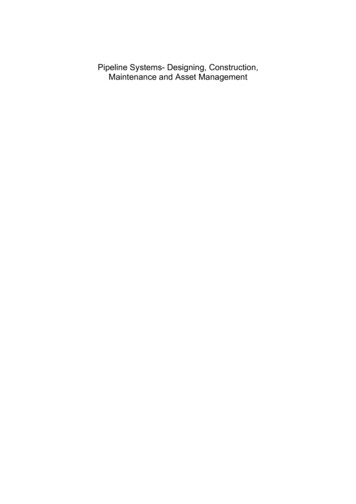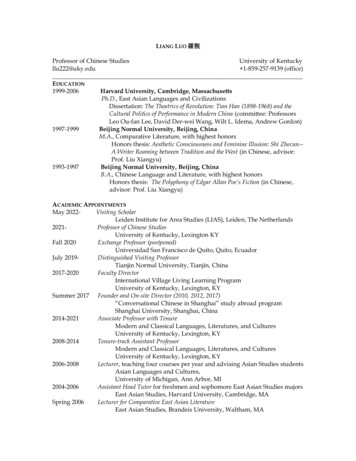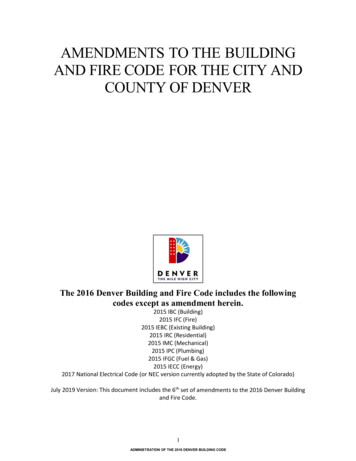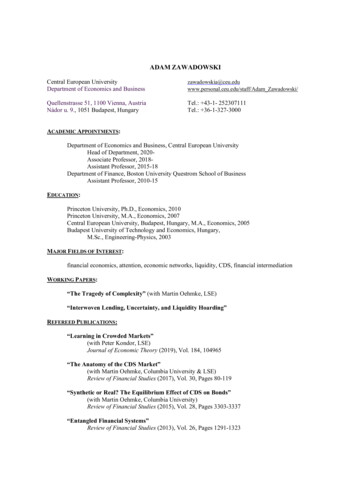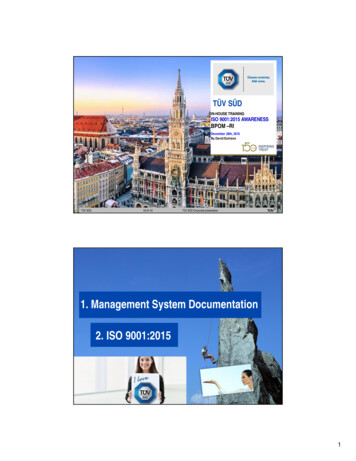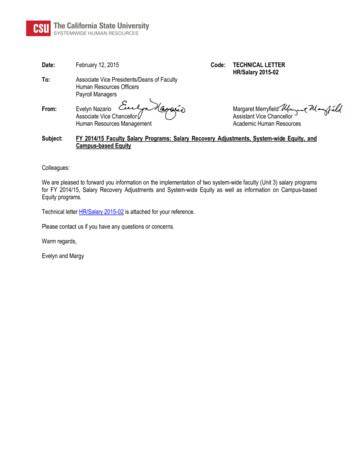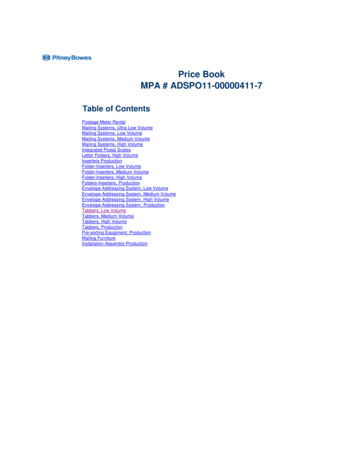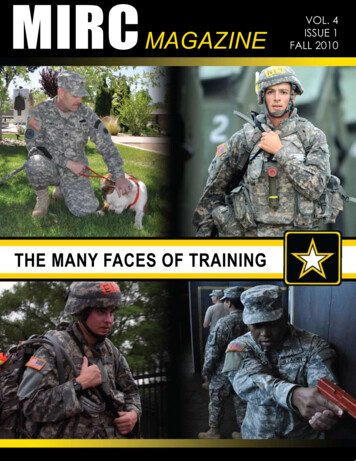
Transcription
80905European Journal of Cardiovascular NursingAstin et al.A Core Curriculum for the ContinuingProfessional Development of NursesWorking in Cardiovascular Settings:Developed by the Education Committeeof the Council on Cardiovascular Nursingand Allied Professions (CCNAP) on behalfof the European Society of Cardiology2015, Vol. 14(S2) S1 –S17 The European Society of Cardiology 2015Reprints and OI: k Force Members: Felicity Astin (former chair) (UK),Diane Carroll (USA), Sabina De Geest (Switzerland), Alberto-LuisFernandez-Oliver (Spain), Janet Holt (UK), Lynne Hinterbuchner(Austria), Catriona Jennings (UK), Ian Jones (UK). Alison Ketchell (UK),Eleni Kletsiou (Greece), Todd Ruppar (USA), Andres Sanchez Bustelo(Spain), Agnieszka Serafin (Poland), Izabella Uchmanowicz (Poland).Contributors and reviewers: Tina Bartley, Nicholas Brooks (former member of ESC Education committee), Kate Exley,Donna Fitzsimmons (former CCNAP chair) and CCNAP Board, Eric Glyde, Lino Goncalves (ESC Education committee),Mary Gobbi, Peter Kearney (ESC Education committee), Aldona Kubica, Mary Mooney, Lars Mathisen, Susanne SPedersen, Jill Riley (chair) and membership of Heart Failure Association Task Force, Mona M Schylter (former chairNational Society) and membership of National Societies, Nancy J Smith, Vikki Taylor, Elizabeth Tolmie, David RThompson, Jan Oliver, Alex Vahanian (ESC Education committee chair) and Sharon Young.1. IntroductionThis document provides an unabridged version of a core curriculum, published in the European Journal of CardiovascularNursing1 developed to inform cardiovascular nursing education in Europe. The core curriculum was designed to functionin two ways. Firstly the curriculum provides a ‘map’ of key content outlined in the syllabus along with suggestions forapproaches to learning and assessment. Secondly the curriculum can be used as a ‘tool’ to support and inform the continuing education and professional development of nurses working in cardiovascular settings across Europe. In particular thecurriculum aims to ‘bridge’ the educational gap between initial qualification as a nurse and the advanced and/or specialistnursing practice required for nurses to work to their full potential in cardiovascular settings. The document represents thefinal output from an ambitious project with inspiration drawn from the Education committee of the ESC who identifiedthe need to develop both core2 and specialist curricula to guide the streamlining of educational preparation of physicianstraining to become cardiologists in Europe. A core curriculum for general cardiology was developed with accompanyingeducational modules delivered through an innovative E-Learning platform (EsCel)3. In following suit we faced additionalchallenges not shared by our medical colleagues. A major consideration concerned the decision about the appropriateeducational level at which to ‘set’ the core curriculum for cardiovascular nursing. Unlike our medical colleagues, the nursing workforce in Europe is not an all graduate profession. Moreover many nurses do not have the opportunity to apply forprofessional registration. We acknowledge and respect the diversity of educational provision for nurses across Europe4and remind readers that this document contains a sample curriculum designed to be used flexibly in a way determined bythe diverse needs of the user. We have purposefully avoided reference to particular benchmark statements as there aresome variances in legal frameworks, professional regulatory requirements, and educational and organisational qualityassurance processes. Different countries and institutions will have developed or adopted specific benchmarks to fulfilparticular needs or to meet country-specific legislative or regulatory requirements. For this reason we have focused ourattention upon central themes and ideas which we believe characterise the learning and education required to equip a
2Core Curriculum 14(S2)newly qualified nurse to work in a cardiovascular setting. We recognise that a continuum of expertise exists leading toadvanced/specialist practice not covered in this core curriculum. The logical building and progression of nursing knowledge, understanding and skills is important. As such curricula that cover advanced/specialist practice are being updated5or are under development. The ESC is made up of myriad organisation and associations. It is envisaged that the core curriculum will articulate with advanced/specialist curricula produced in the future by each group represented in Figure 1.Educational modules that reflect the core curriculum content are also under development.Figure 1. A diagrammatic representation of how the core curriculum ‘fits’ with other advanced/specialist nursing curricula underdevelopment.2. Pedagogical Approach and Educational PhilosophyThere are many definitions of pedagogy. Perhaps the simplest is ‘The science of teaching’6. However, the term denotesmore than just a set of teaching techniques. Pedagogy encompasses: why it is taught or learned - the underpinning values, philosophy or rationale. what is taught/learned - the content how it is taught or learned - approaches to teaching and learningThe three elements are intertwined and the ‘why’ will have a strong influence on what is taught or learned and how. Wegave attention to all three elements in the development of the curriculum. In the next section we present a range of theoriesand ideas that informed the curriculum.2.1 Learners and Learning at the CentreOur view is that the learner should be at the heart of the learning process. Accordingly we promote the idea of learners aspartners who are encouraged to shape their own learning. The concept of the ‘expert learner’ is central to current
Astin et al.3developments in the personalisation of learning in which the learner is encouraged to plan, organise and evaluate their ownlearning7. We share this view and emphasise the importance of fostering active, participative and autonomous learners tocultivate professional autonomy, deliver evidence based practice and lead the profession of nursing. Our belief is that thefocus of educational practice should shift away from the view of the teacher as the imparter of educational content andinformation towards the model of the teacher as the learning facilitator. In this way the role of the teacher is to support thelearner, both directly and indirectly, in all aspects of learning.2.2 Co-operative LearningCo-operative learning is an approach commonly used in education which recognises the value of learners working together onstructured tasks8. In contrast to individual learning, which can foster a competitive environment, co-operative learning capitalises on individuals learning from one another. Effective co-operative learning recognises that success is achieved only if allmembers of the group are accountable and work together in an interactive way to achieve shared goals8. This approach isespecially appropriate because it mirrors the multidisciplinary teamwork and collaboration that occurs in clinical practice.2.3 Experiential LearningEducational theory recognises the significance of learning from experience. This is especially pertinent to nursing educationwhich is firmly grounded in clinical practice. Experiential learning recognises the importance of doing, observing, thinking,reflecting and planning as part of creating knowledge9. Learners make discoveries and experiment with knowledge firsthand, instead of hearing about, or reading about, the experiences of others. When learners reflect on their experiences, theydevelop new skills and attitudes, new theories and ways of thinking, resulting in deep understanding and emotional andaffective change. Experiential learning enables us to construct new knowledge, systematically, from our experiences.The nurse theorist, Patricia Benner, provides us with a useful model that describes a continuum of nursing experience made up of five levels ranging from novice to expert9 (Figure 2). We used this model to help us think about theintended educational level of this curriculum. We concluded that our students would be considered competent in adultnursing, if they had completed initial educational preparation for nursing within their country, but with regard to cardiovascular nursing would be considered to be at novice level. This enabled us to distinguish between the educationalcontent that would be included in the core curriculum as opposed to more specialist or advanced educational content.Figure 2. The continuum of nursing experience.Adapted from Benner (1982)10
4Core Curriculum 14(S2)3. Assessment for LearningAssessment and feedback is built in to all successful teaching and learning activities but the process does not alwayshave to be teacher led and can incorporate peer or self-assessment. In addition computer-based tasks, if carefullydesigned, can build in intrinsic feedback that encourages learner reflection and improvement. Rather than being prescriptive we have opted to identify some key factors to consider in the development of assessment approaches.Methods - What assessment methods will be used to enable the learner and the teacher to judge whether the learningoutcomes have been met.Purpose - It is important to highlight that assessment can be used for diagnostic (to judge starting levels), formative(to give feedback) and summative (to grade) purposes. It is important to highlight both formative (to give feedback) andsummative (to grade) assessments.Grading - To communicate relative importance or the breakdown of marks for different components of the assessmentand their individual assessment criteria.Procedures – e.g. re-takes, marking processes, schedules (when can assessments be taken) etcSome suggested assessment approaches are; Written essayShort answer examReflection/ Reflective writing assignmentsMultiple choice questionsObserved structured clinical examinationAssessment of competence in practiceBlogs and Learning DiariesPortfolioViva vocePoster presentation, vignettes & discussions3.1 Approaches to Learning and TeachingEach educational institution will have a unique approach to teaching, learning and assessment. Our aim is not to beprescriptive but to outline a range of approaches with the emphasis being on the use of a mix of modes that could beused to support learners in achieving the given learning outcomes. The choice of teaching and learning approaches willbe guided by the course philosophy and the way in which the course is delivered. Some examples are: Didactic lecturesSeminar group discussionsOnline lectures and interactive tutorialsDiscussion boardsClinical teachingProblem based learning case study discussionsExperiential learning through simulated practice.E-Learning such as online information with self testsGuided reflectionDVD and CD RomPeer led team learningJournal clubs4. The Core Curriculum4.1 AimsThe specific aims of the core curriculum were that on completion of training pathway students should have provided evidence of being able to: Understand and demonstrate coherent and detailed knowledge and understanding of adult cardiovascular nursing care Develop clinical skills in cardiovascular nursing to support practice within the legislative and regulative frameworks and scope of practice of the host country
Astin et al.5 Demonstrate the delivery of high quality, age/gender appropriate and culturally competent care, characterised by acaring and compassionate approach and underpinned by effective communication skills Work in partnership with service users, carers, and families to promote positive health and prevent illness throughindividualised care that accounts for varying health literacy levels Identify and implement clinical guidelines and other sources of research evidence relevant to nursing practice inorder to provide nursing care that is safe, effective and evidence based Work inter-professionally with all members of the health and social care team to identify health care needs, and developindividualised plans of care leading to positive health care outcomes for adult service users, families and carers Reflect upon and apply ethical and legal principles to cardiovascular nursing care and practice within the professional boundaries and guidelines of the professional regulatory bodies and institutions of the host country Develop leadership and management skills and contribute to service design and delivery in order to maintain andimprove standards of care5. ContentThe identification of relevant content constituted the first step in the development of the core curriculum. The syllabus wasdeveloped by a panel of experts and subject to rigorous review as part of a consultation process. The syllabus and core curriculum seek to shift the emphasis away from the biomedical approach to care delivery and strengthen the person and familycentred perspective. The key components of person and family centred care identified in a concept analysis11were integratedinto the content; these were effective communication, learning and teaching skills, the ability to facilitate patient autonomyand provide individualised care in a respectful manner. In addition the key markers of a high quality hospital care asreported by in-patients were integrated into the syllabus12. The importance of research and evidence based practice isemphasised and learning and teaching approaches can reflect this requirement through fostering autonomous inquiry andthe implementation of ESC guidelines. Moreover it is acknowledged that the cardiovascular patient population will increasingly be composed of people aged over 65 years of age living with multiple co-morbidities such as dementia13.The syllabus content is arranged under 8 themes which characterise the core curriculum shown in Figure 3. Althoughthese are presented separately some overlap across themes is unavoidable.5.1 SyllabusIn this section the 8 themes that characterise the core curriculum shown in Figure 3 will be presented in detail.Theme 1: Fundamentals of Cardiovascular PathophysiologyContent will include learning about anatomy, pathophysiology and physical manifestations of common cardiovascularconditions together with the recognition of normal and altered physiological parameters and their clinical significance. Wearranged this content to reflect four broad groupings;1.2.3.4.Atherosclerotic disease and associated conditions: (ischaemic heart disease, stroke and peripheral vasculardisease)Heart rhythm and conduction disorders (tachy/brady arrhythmia, conduction defects)Structural abnormalities of the heart (grown up congenital heart disease GUCH, valve disease)Heart muscle disorders (infective, inflammatory, acute and chronic heart failure, cardiogenic shock)Theme 2: Optimising Cardiovascular Health for People and PopulationsContent will include learning about cardiovascular risk assessment and interventions to support prevention together withinstruction about how such health priorities can be implemented in practice;a) The burden of cardiovascular disease across Europe/world (health inequalities and patterns of comorbidityacross the life span)b) Modifiable, non-modifiable, novel and emerging cardiovascular risk factors across the lifespan and advances ingenetic testingc) Primary and secondary prevention strategies (population and individual level)d) Individualised and family centred cardiovascular risk assessmente) Introduction to theory and principles of behaviour changef) Interventions (population, individual and family focused) to promote a healthy lifestyle and support adherenceto prescribed medicationsg) Implementation of clinical guidelines in practice (nursing contribution)
6Core Curriculum 14(S2)Fundamentalsof CardiovascularPathophysiology Anatomy, pathophysiology and clinical manifesta ons Recognising clinical deteriora on Atherosclero c disease Heart rhythm and conduc on Structural abnormali es Heart muscle disordersOp misingCardiovascular Healthfor People &Popula ons Global CVD burden Coronary risk factors Risk assessment Behaviour change Interven ons to aid preven onAssessment, Planning& Managing Care Cardiovascular assessment Diagnos c tests ECG Skills Life Support Skills Pharmacology Nursing care plansPrinciples & Prac cesof Person & FamilyCentred Care Person centred care Shared decision making Reflec ve prac ce Tools and approachesEduca on &Communica onEmo onal & SpiritualWell-BeingPhysical Well-Being& ComfortEvalua on of theQuality of Care Educa on and adult Learning Communica on skills Health literacy Emo onal responses and self-care Prevalence of maladapta on Screening tools Nursing interven ons Pa ent safety Symptom management Exercise and rehabilita on End of life care Systems and organisa onal theory Quality care and quality indicators Care coordina on Risk assessment, pa ent safety, audit and evalua on Role of technology in pa ent safetyFigure 3. Core Curriculum Themes and Indicative Content.Theme 3: Assessment, Planning and Managing CareContent covered in initial nurse education will be further developed to focus upon care of the patients living with a cardiovascular condition. Content will include:a) Cardiovascular health assessment (taking a cardiac history and focused physical assessment) and review of lifesupport skillsb) Diagnostic tests including ECG/telemetry (non- invasive imaging such as echocardiography, magnetic resonance imaging, computerised tomography, nuclear imaging and invasive imaging such as cardiac catheterisationand angiography)
Astin et al.7c) Common pharmacological agents prescribed in cardiovascular care (antihypertensives, diuretics, lipid loweringagents, antiplatelet agents, antithrombotics, thrombolytics, antiarrhythmics, initiation, mode of action and interactions)d) Development, implementation and evaluation of a nursing care plan using evidence-based clinical guidelines inpractice with emphasis on nursing contributionThe aforementioned cross-cutting ‘threads’ will be applied comprehensively across the key cardiovascular conditionsidentified in Theme 1;1.2.3.4.Atherosclerotic disease and associated conditions: (ischaemic heart disease, stroke and peripheral vasculardisease)Heart rhythm and conduction disorders (tachy/brady arrhythmia, conduction defects)Structural abnormalities of the heart (grown up congenital heart disease GUCH, valve disease)Heart muscle disorders (infective, inflammatory, acute and chronic heart failure, cardiogenic shock)Theme 4: Principles and Practices of Person and Family Centred CareThe content in this domain links to all syllabus areas and focuses upon the concept of person and family centred care andshared decision making. The principles and processes of reflective practice will be an integral part of the learning and willbe linked to the use of patient feedback to inform cardiovascular service improvement.a)b)c)d)Person and family centred nursing careShared decision making and barriers and facilitators to collaborative partnershipsReflective practice (evidence-based nursing experience)Interventions and tools used to support person centred care and shared decision makingTheme 5: Education and CommunicationContent will include learning about adult learning theory and health literacy which will link with effective communicationskills. These skills will underpin knowledge about effective health behaviour change.a)b)c)d)e)f)Introduction to educational theory and principles of adult learningHealth literacy theory and health information needsTheory and principles of family assessmentPrinciples and practices of effective communicationIntroduction to educational/behavioural interventionsImplementation of clinical guidelines in practice (Nursing contribution)Theme 6: Emotional and Spiritual Well-BeingThis theme will link to content outlined in Themes 1. Fundamentals of Cardiovascular Pathophysiology and 3. Assessing,Planning and Managing Care. People living with cardiovascular conditions experience a range of negative emotions.Content will focus upon nursing interventions to enhance emotional and spiritual well-being in people with cardiovasculardisease.a) Emotional responses across the patient’s journey (diagnosis, hospitalisation, treatment, discharge and long termself-care including lifestyle changes and adherence to medicines)b) Prevalence and incidence of negative emotional responses and their impact on coping and health related qualityof life (stress, anxiety, depression, hostility, anger, denial, health related quality of life)c) Introduction to screening and assessment tools designed to evaluate psychological well-being and health relatedquality of lifed) Nursing interventions to support emotional and spiritual well-beinge) Implementation of clinical guidelines in practice (nursing contribution)Theme 7: Physical Well-Being and ComfortThis theme will link to content outlined in Themes 1. Fundamentals of Cardiovascular Pathophysiology and 3. Assessment,Planning and Managing Care. People living with cardiovascular conditions experience a range of symptoms which,
8Core Curriculum 14(S2)individually, are often non-specific to a particular condition. Accordingly content will focus upon nursing interventionsdesigned to enhance physical comfort and well-being in people with cardiovascular disease;a) Patient safety in cardiovascular settingb) Presentation, prevalence, causation, assessment and management of cardiovascular symptoms:c)d)e)f)g)Pain (acute and chronic, chest pain, pain from surgical wounds/intermittent claudication/limb contractures)Shortness of breath (acute and chronic)Gastro-intestinal symptoms (hepatic)Fatigue, tiredness and sleep disturbancePalpitations and syncopeOedemaLoss of appetite and cachexiaMedication side effectsExercise and rehabilitationSexual counsellingEnd of life careImplementation of clinical guidelines in practice (nursing contribution)Theme 8: Evaluation of the Quality of CareThis content will support learning about systems and organisational theory that underpins quality care. The principles andpractices of a quality improvement framework will be applied to care processes in cardiovascular care settings to demonstrate the link between care processes and patient outcomes.a) Definitions of high quality nursing careb) Identification of quality indicator measures that can be usedc) Nurses role, as part of healthcare team, to promote a culture of safety leading to safe, effective, compassionate,high quality cared) The use of health care quality assessment methods and outcome data to assess risk, promote patient safety, conduct audits and evaluations to improve health care systemse) The role of technology in promoting quality and safety in healthcare settingsf) Effective communication, shared decision making and cultural sensitivity6. Core Curriculum ThemesIn the next section the core curriculum themes will be presented with learning outcomes, knowledge and skills.Theme 1. Fundamentals of Cardiovascular PathophysiologyLearning outcomes: Understand normal and altered anatomy and physiology of the CV system Describe the pathophysiological changes that manifest in common CV disorders Recognise the pathophysiological mechanism basis of signs and symptoms and changes indicative ofdeteriorationKnowledge:Understand the anatomy, pathophysiology and physical manifestations of common CV conditions outlined below: Atherosclerotic disease (*IHD, stroke, *PVD)Heart rhythm and conduction disorders (tachy/brady arrhythmia, conduction defects)Structural abnormalities of the heart (grown up congenital heart disease GUCH, valve disease)Heart muscle disorders (infective, inflammatory, acute and chronic heart failure, cardiogenic shock)
Astin et al.9Skills: Apply knowledge of anatomy, physiology and pathophysiology, in clinical practice, and recognise the clinicalmanifestations of CVD Recognise normal ranges of physiological parameters and distinguish between those that are normal, abnormal andlife-threatening Accurately measure and document physiological parameters and take appropriate action in response to alternationsin physiological parametersAttitudes & Behaviours: Appreciate the importance of continuing to review knowledge of pathophysiological principles*IHD Ischaemic heart disease (stable angina and acute coronary syndrome)*PVD Peripheral vascular diseaseTheme 2. Optimising Cardiovascular Health for People and PopulationsLearning outcomes: Identify risk factors associated with *CVD and recognise the impact of health inequalities on their distribution Demonstrate a working knowledge of ESC guidelines on prevention Apply evidence based strategies for the prevention of CVD in practiceKnowledge: Outline the burden of CVD locally and globally Identify modifiable, non-modifiable, emerging and novel *CV risk factors across the lifespan Demonstrate knowledge and understanding of ESC prevention guidelines for the management of Hypertension Tobacco smoking Dyslipidaemia Diabetes and metabolic syndrome Lifestyle Outline key theories and principles that underpin health behaviour change and relevance to clinical practice andcardiac rehabilitation Describe prevention interventions used to reduce CVD mortality and morbiditySkills:The ability to: Use effective interview skills to obtain patient history to identify *CV risk factors Educate the patient and family about the importance of risk factor management and support self-management ofhealthy lifestyle changes Develop, document and evaluate prevention plan Search, critically appraise and interpret published literature Identify patients at risk for unnecessary hospitalisations and readmissions Select appropriate prevention programs for implementation by multidisciplinary teamAttitudes & Behaviours: Display a non-judgemental attitude and respect for patient choice Provide equitable care for all without discrimination
10Core Curriculum 14(S2) Collaborate with the multidisciplinary team in optimising *CV health Promote effective communication between team members, patient and family Recognise the role of the nurse, (actual and potential), in the implementation of *EBP*CV Cardiovascular, *CVD Cardiovascular Disease, *MDT Multidisciplinary Team, *EBP Evidence Based Practice.Theme 3. Assessment, Planning and Managing CareLearning outcomes: Demonstrate the ability to collect data in a systematic way which accurately reflects the immediate condition oranticipated needs of the patient Determine the nursing diagnosis or health-related complaint from assessment data Identify expected nurse sensitive outcomes with the patient, family and other healthcare providers Demonstrate the ability to analyze data to plan care and attain defined outcomes for a range of *CV disorders Implement an evidence-based plan of care and coordinate care delivery and evaluation for patients with a range of*CV disordersKnowledge: Describe how to collect data for a CV health assessmentExplain how to plan, implement and evaluate a care plan for CV patientsDescribe principles and the safe practice of *invasive and non-invasive haemodynamic monitoringDescribe key diagnostic tests (*invasive and non-invasive) and how you would prepare the patient, family, environment and equipmentReview life support skills in line with relevant clinical guidelinesDescribe common pharmacological agents prescribed in cardiovascular care (antihypertensives, diuretics, lipidlowering agents, antiplatelet agents, antithrombotics, thrombolytics, antiarrhythmics including initiation, mode ofaction and interaction)Identify relevant clinical guidelines and explain how to implement in practice (nursing contribution)Apply the above to conditions listed below: Atherosclerotic disease and associated conditions (IHD, stroke and PVD): Emergency and elective revascularisation approaches. Life support skills. Heart rhythm and conduction disorders: elective and emergency cardioversion, ablation, ICD*, CRT*. Structural abnormalities: valvuloplasty, valve replacement, grown up congenital heart disease and structuralrepairs, Heart muscle disorders: ICD, CRT, LVAD*, transplant.Skills: Describe the principles and processes required to develop and evaluate a comprehensive, patient centred, plan ofcare Take an accurate history and perform a comprehensive physical and psychosocial health assessment Demonstrate the ability to correctly prepare the patient, environment and equipment required to establishvenous and/or arterial access for a range of cardiology related interventions* together with ongoing nursingmanagement Demonstrate the ability to correctly prepare the patient, environment and *equipment required for a range of invasive and non-invasive cardiology related diagnostic tests* Demonstrate the ability to provide safe, effective and compassionate nursing care reflected in accurate documentation for patients undergoing cardiology related interventions* and invasive and non-invasive cardiology relateddiagnostic tests* Demonstrate the safe administration of cardiology related medications Demonstrate effective life support skills
Astin et al.11Attitudes & Behaviours: Consider the patient’s ability to provide data to allow sufficient time to describe symptoms in their own wordsEmpathize and respect patients’ socio-economic, ethnical, cultural, and religious backgroundMaintain privacy, dignity and confidentialityRecognise the boundaries of your own scope of practiceAdhere to local policies and protocols regarding medicine administrationRecognise the importance of the accurate documentation of patient care*Invasive and non-invas
developed by a panel of experts and subject to rigorous review as part of a consultation process. The syllabus and core cur - riculum seek to shift the emphasis away from the biomedical approach to care delivery and strengthen the person and family centred perspective. The key components of person and family centred care identified in a concept .
